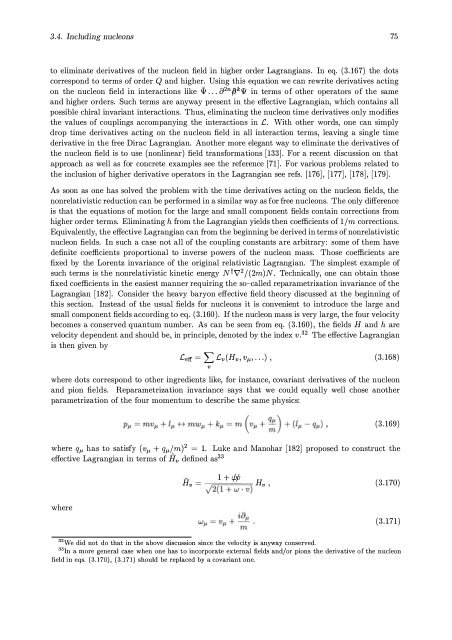The Nucleon-Nucleon Interaction in a Chiral Effective Field Theory
The Nucleon-Nucleon Interaction in a Chiral Effective Field Theory
The Nucleon-Nucleon Interaction in a Chiral Effective Field Theory
You also want an ePaper? Increase the reach of your titles
YUMPU automatically turns print PDFs into web optimized ePapers that Google loves.
3.4. Inc1ud<strong>in</strong>g nuc1eons 75<br />
to elim<strong>in</strong>ate derivatives of the nucleon field <strong>in</strong> higher order Lagrangians. In eq. (3.167) the dots<br />
correspond to terms of order Q and higher. Us<strong>in</strong>g this equation we can rewrite derivatives act<strong>in</strong>g<br />
on the nucleon field <strong>in</strong> <strong>in</strong>teractions like � ... 82n fJk'J! <strong>in</strong> terms of other operators of the same<br />
and higher orders. Such terms are anyway present <strong>in</strong> the effective Lagrangian, which conta<strong>in</strong>s all<br />
possible chiral <strong>in</strong>variant <strong>in</strong>teractions. Thus, elim<strong>in</strong>at<strong>in</strong>g the nucleon time derivatives only modifies<br />
the values of coupl<strong>in</strong>gs accompany<strong>in</strong>g the <strong>in</strong>teractions <strong>in</strong> L. With other words, one can simply<br />
drop time derivatives act<strong>in</strong>g on the nucleon field <strong>in</strong> all <strong>in</strong>teraction terms, leav<strong>in</strong>g a s<strong>in</strong>gle time<br />
derivative <strong>in</strong> the free Dirac Lagrangian. Another more elegant way to elim<strong>in</strong>ate the derivatives of<br />
the nucleon field is to use (nonl<strong>in</strong>ear ) field transformations [133]. For a recent discussion on that<br />
approach as well as for concrete examples see the reference [71]. For various problems related to<br />
the <strong>in</strong>clusion of higher derivative operators <strong>in</strong> the Lagrangian see refs. [176], [177], [178], [179].<br />
As soon as one has solved the problem with the time derivatives act<strong>in</strong>g on the nucleon fields, the<br />
nonrelativistic reduction can be performed <strong>in</strong> a similar way as for free nucleons. <strong>The</strong> only difference<br />
is that the equations of motion for the large and small component fields conta<strong>in</strong> corrections from<br />
higher order terms. Elim<strong>in</strong>at<strong>in</strong>g h from the Lagrangian yields then coefficients of 1/ m corrections.<br />
Equivalently, the effective Lagrangian can from the beg<strong>in</strong>n<strong>in</strong>g be derived <strong>in</strong> terms of nonrelativistic<br />
nucleon fields. In such a case not all of the coupl<strong>in</strong>g constants are arbitrary: so me of them have<br />
def<strong>in</strong>ite coefficients proportional to <strong>in</strong>verse powers of the nucleon mass. Those coefficients are<br />
fixed by the Lorentz <strong>in</strong>variance of the orig<strong>in</strong>al relativistic Lagrangian. <strong>The</strong> simplest example of<br />
such terms is the nonrelativistic k<strong>in</strong>etic energy Nt\!2/ (2m)N. Technically, one can obta<strong>in</strong> those<br />
fixed coefficients <strong>in</strong> the easiest manner requir<strong>in</strong>g the so-called reparametrization <strong>in</strong>variance of the<br />
Lagrangian [182]. Consider the heavy baryon effective field theory discussed at the beg<strong>in</strong>n<strong>in</strong>g of<br />
this section. Instead of the usual fields for nucleons it is convenient to <strong>in</strong>troduce the large and<br />
small component fields accord<strong>in</strong>g to eq. (3.160). If the nucleon mass is very large, the four velo city<br />
becomes a conserved quantum number. As can be seen from eq. (3.160), the fields H and h are<br />
velocity dependent and should be, <strong>in</strong> pr<strong>in</strong>ciple, denoted by the <strong>in</strong>dex v.32 <strong>The</strong> effective Lagrangian<br />
is then given by<br />
Leff = L Lv (Hv, vf.t, ... ) , (3.168)<br />
v<br />
where dots correspond to other <strong>in</strong>gredients like, for <strong>in</strong>stance, covariant derivatives of the nucleon<br />
and pion fields. Reparametrization <strong>in</strong>variance says that we could equally well chose another<br />
parametrization of the four moment um to describe the same physics:<br />
(3.169)<br />
where qf.t has to satisfy (vf.t + qf.t/m)2 = 1. Luke and Manohar [182] proposed to construct the<br />
effective Lagrangian <strong>in</strong> terms of Hv def<strong>in</strong>ed as33<br />
where<br />
- 1 + #<br />
Hv = Hv ,<br />
J2(1 +w·v)<br />
(3.170)<br />
(3.171)<br />
32We did not do that <strong>in</strong> the above discussion s<strong>in</strong>ce the velo city is anyway conserved.<br />
33In a more general case when one has to <strong>in</strong>corporate external fields and/or pions the derivative of the nucleon<br />
field <strong>in</strong> eqs. (3.170), (3.171) should be replaced by a covariant one.












